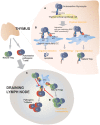MHC Class II Polymorphisms, Autoreactive T-Cells, and Autoimmunity
- PMID: 24133494
- PMCID: PMC3794362
- DOI: 10.3389/fimmu.2013.00321
MHC Class II Polymorphisms, Autoreactive T-Cells, and Autoimmunity
Abstract
Major histocompatibility complex (MHC) genes, also known as human leukocyte antigen genes (HLA) in humans, are the prevailing contributors of genetic susceptibility to autoimmune diseases such as Type 1 Diabetes (T1D), multiple sclerosis, and rheumatoid arthritis, among others (1-3). Although the pathways through which MHC molecules afford autoimmune risk or resistance remain to be fully mapped out, it is generally accepted that they do so by shaping the central and peripheral T-cell repertoires of the host toward autoimmune proclivity or resistance, respectively. Disease-predisposing MHC alleles would both spare autoreactive thymocytes from central tolerance and bias their development toward a pathogenic phenotype. Protective MHC alleles, on the other hand, would promote central deletion of autoreactive thymocytes and skew their development toward non-pathogenic phenotypes. This interpretation of the data is at odds with two other observations: that in MHC-heterozygous individuals, resistance is dominant over susceptibility; and that it is difficult to understand how deletion of one or a few clonal autoreactive T-cell types would suffice to curb autoimmune responses driven by hundreds if not thousands of autoreactive T-cell specificities. This review provides an update on current advances in our understanding of the mechanisms underlying MHC class II-associated autoimmune disease susceptibility and/or resistance and attempts to reconcile these seemingly opposing concepts.
Keywords: MHC class II; T regulatory cells; autoimmune diseases; autoreactive T cells; resistance genes; susceptibility genes; type 1 diabetes.
Figures


References
Publication types
LinkOut - more resources
Full Text Sources
Other Literature Sources
Research Materials

